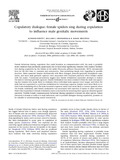Mostrar el registro sencillo del ítem
Copulatory dialogue: female spiders sing during copulation to influence male genitalic movements
| dc.creator | Briceño Lobo, Daniel | |
| dc.creator | Eberhard Chabtree, William G. | |
| dc.creator | Paretti, Alfredo | |
| dc.date.accessioned | 2013-12-10T21:36:35Z | |
| dc.date.available | 2013-12-10T21:36:35Z | |
| dc.date.issued | 2006 | |
| dc.identifier.citation | http://www.sciencedirect.com/science/article/pii/S0003347206001825 | |
| dc.identifier.issn | 0003-3472 | |
| dc.identifier.uri | https://hdl.handle.net/10669/8934 | |
| dc.description | artículo (arbitrado)--Universidad de Costa Rica, 2006. Este artículo es privado debido a limitaciones de derechos de autor. | es_ES |
| dc.description.abstract | Female behaviour during copulation that could function as communication with the male is probably more common than previously appreciated, but its functional significance remains little studied. Stridulation during copulation by the female of the spider Physocylus globosus (Taczanowski, 1873), documented here for the first time, is common and noncoercive, thus permitting simple tests regarding its possible function. Males squeezed females rhythmically with their enlarged, powerful genitalia throughout copulation, and more male genitalic squeezes were associated with increased paternity when females mated with two males. Contextual associations suggest that female stridulation represents attempts to induce the male to interrupt genitalic squeezes: female stridulation was more common when the male was squeezing her; females were more likely to stridulate when individual male squeezes were longer, and when the male had not responded to a previous stridulation by loosening a squeeze; females were more likely to refrain from stridulating when the male loosened a squeeze; males were more likely to loosen squeezes when the female stridulated; and female stridulation was associated with rejection of males in other contexts. Males that responded to female stridulation more consistently by loosening their squeezes obtained greater paternity. Possible female communicatory behaviour during copulation is known in other species. Future attention to female as well as to male behaviour, and to possible dialogues during copulation, promises to be valuable in understanding sexual interactions. | es_ES |
| dc.description.sponsorship | Universidad de Costa Rica. Universidad Nacional de Córdoba, Argentina. Smithsonian Tropical Research Institute | es_ES |
| dc.language.iso | en_US | es_ES |
| dc.publisher | Animal Behaviour, 2006, 72, 413-421 | es_ES |
| dc.subject | Reproducción sexual | es_ES |
| dc.subject | Physocylus globosus | es_ES |
| dc.subject | Araña | es_ES |
| dc.subject | Sonido | es_ES |
| dc.title | Copulatory dialogue: female spiders sing during copulation to influence male genitalic movements | es_ES |
| dc.type | artículo original | |
| dc.identifier.doi | 10.1016/j.anbehav.2006.01.014 | es_ES |
| dc.description.procedence | UCR::Vicerrectoría de Docencia::Ciencias Básicas::Facultad de Ciencias::Escuela de Biología | es_ES |
Ficheros en el ítem
Este ítem aparece en la(s) siguiente(s) colección(ones)
-
Biología [1635]


